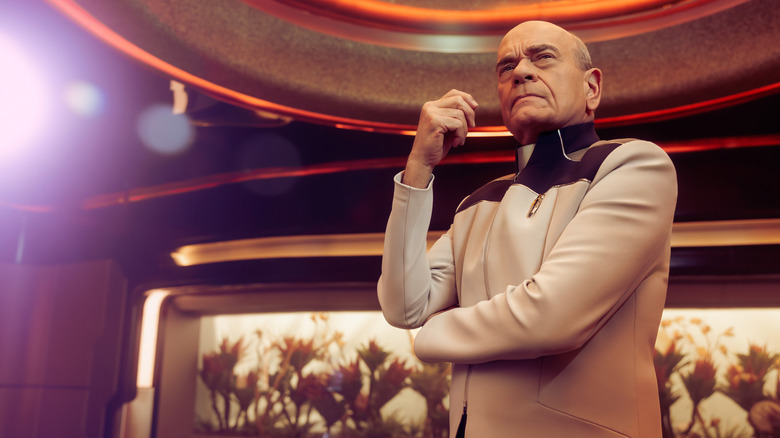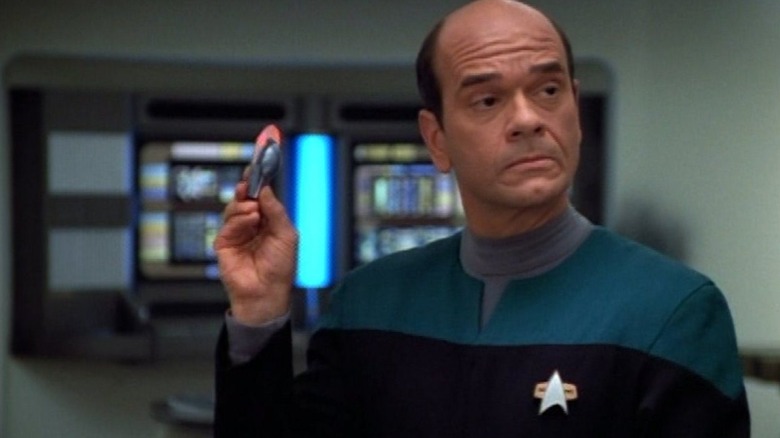Star Trek's Robert Picardo Had To Make One Change To The Doctor For Starfleet Academy
The new TV series "Star Trek: Starfleet Academy" will debut in the early months of 2026, making it the 15th "Star Trek" TV series to date (provided you count "Short Treks" and "Very Short Treks" as separate entities). It will share some common characters from the later seasons of "Star Trek: Discovery," and will be set in the 32nd century, which is many centuries beyond most of the "Star Trek" shows. Because of its advanced point in the "Star Trek" timeline, there will be few opportunities to include legacy characters from older Trek shows ... unless, of course, they include a character who is either very long-lived or downright immortal.
Luckily, "Star Trek" does contain several of those, including the Doctor (Robert Picardo) from "Star Trek: Voyager." The Doctor is a hologram that originally served as an emergency replacement for the U.S.S. Voyager's medical staff, and had to remain activated for prolonged periods, imbuing him with consciousness. At first, the Doctor had to remain relegated to sickbay, where the holographic emitters were equipped, but he was eventually given an advanced mobile emitter that allowed him to go anywhere he pleased. Because he's made of light and force fields, he's essentially immortal. The Doctor has already made an appearance on "Star Trek: Prodigy," and will be a main character on "Starfleet Academy," set 900 yeas later.
There will be a few changes to the Doctor since last we saw him, of course. For one, actor Robert Picardo is now 71, so the Doctor will have altered his visual matrix to look more like a 71-year-old man (which is wholly appropriate for a 900-year-old entity). For another, his language will have evolved somewhat. That second point was a concern Picardo addressed at the recent San Diego Comic-Con, handily covered by CinemaBlend. He noted that the language of the 24th century wouldn't sound the same as in the 32nd, and that his character would be more hip to 32nd century colloquialisms.
The Doctor will speak using more casual 32nd century language
It's worth noting that "Starfleet Academy" will surround a group of cadets, most of them about 18 years old (or their home-planet's equivalent). Indeed, one of the characters, S.A.M. (Kerrice Brooks), is also a hologram, and was activated only a few weeks prior to the events of the series. They are all very young, is the point. The Doctor will not only have updated his language with the passing centuries, but in interacting with the youths of the 32nd century, will also learn their slang. As Picardo put it:
"The language is different in the 32nd century than it was in the 24th century. We never said any bad words in the 24th century. We spoke sort of this not Mid-Atlantic English, sort of mid-Galactic English, so there are differences in the show that I had to get used to. Mostly, it was the way the cadets spoke, and then I had to use their own vernacular when I talked to them. So I speak differently as well, but it's a reaction, and it's to gain their attention and hopefully their respect."
Picardo also remembered, though, that he is a returning legacy character on "Academy," and that he needed to be mindful of his connection to the character's past. As such, he had to knowingly serve as a role model for his young co-stars, reminding them that "Star Trek" is something an actor takes quite seriously. This was similar to the way his character has to serve as a role model for the cadets he teaches, so character and actor kind of dovetailed.
As of this writing, Picardo is the only actor — and the Doctor the only character — linking "Academy" to any of the pre-"Discovery" Trek shows. This is a hefty responsibility for Picardo, indeed. But given how prolific an actor he has always been, it shouldn't cause him too much trouble.

